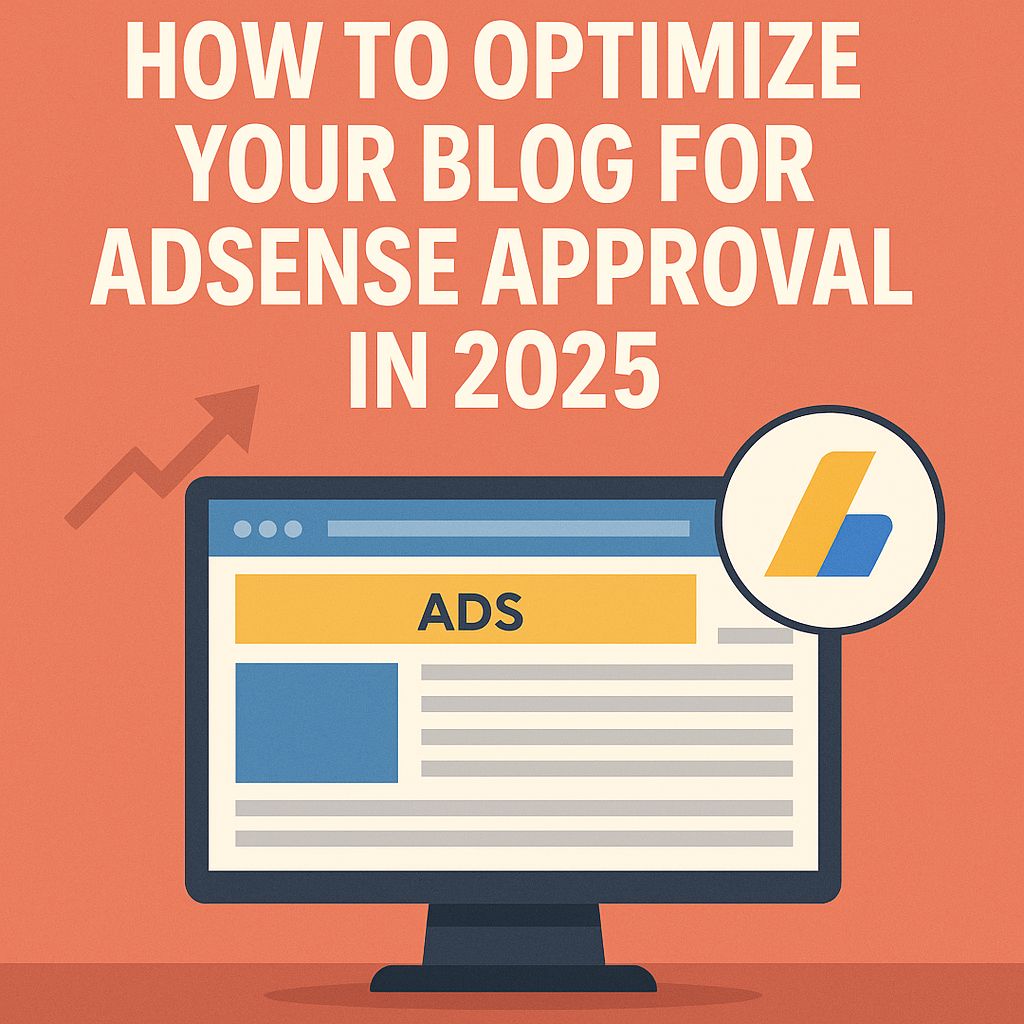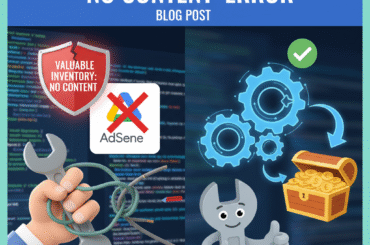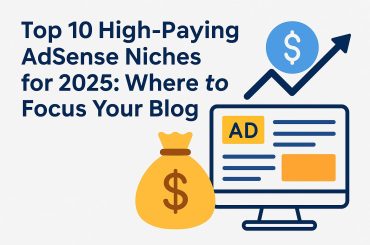How to Optimize Your Blog for AdSense Approval in 2025
Google AdSense remains one of the most popular ways for bloggers to monetize their content. However, getting approved for AdSense in 2025 is no walk in the park. Google has become increasingly strict, prioritizing high-quality content, user experience, and compliance with its policies. To help you navigate this process, this guide outlines actionable steps to optimize your blog for AdSense approval in 2025. By focusing on content quality, technical optimization, and policy adherence, you can increase your chances of success.
Understanding Google AdSense Requirements in 2025
Before diving into optimization strategies, it’s crucial to understand what Google AdSense looks for in 2025. Google prioritizes:
- High-Quality Content: Unique, valuable, and engaging content that serves your audience.
- User-Friendly Design: A clean, navigable website with a positive user experience.
- Policy Compliance: Adherence to AdSense program policies, including no prohibited content (e.g., adult material, copyrighted content, or misleading information).
- Traffic and Engagement: While not explicitly required, blogs with consistent traffic and user engagement are more likely to get approved.
- Technical Optimization: A fast, mobile-friendly, and secure website.
With these in mind, let’s explore how to optimize your blog step-by-step.
1. Create High-Quality, Original Content
Content is the backbone of your blog and the primary factor Google evaluates for AdSense approval.
Write Valuable and Unique Content
- Focus on Your Niche: Choose a specific niche (e.g., technology, health, finance) and create content that addresses your audience’s needs. Avoid generic or overly broad topics.
- Produce In-Depth Articles: Aim for long-form content (800+ words) that provides detailed insights, actionable tips, or unique perspectives. For example, instead of writing “Top 10 Tips for Blogging,” create a comprehensive guide like “How to Build a Profitable Blog in 2025.”
- Avoid Plagiarism: Use tools like Copyscape or Grammarly to ensure your content is 100% original. Google penalizes duplicated or scraped content.
Optimize Content for SEO
- Keyword Research: Use tools like Ahrefs, SEMrush, or Google Keyword Planner to identify low-competition, high-traffic keywords relevant to your niche.
- On-Page SEO: Include your target keyword in the title, meta description, headers, and naturally throughout the content. For example, this article targets “optimize blog for AdSense approval 2025.”
- Internal and External Linking: Link to other relevant posts on your blog and credible external sources to enhance content authority.
Post Consistently
- Aim for at least 20–30 high-quality posts before applying for AdSense. Consistency signals to Google that your blog is active and reliable.
- Create a content calendar to maintain a regular posting schedule (e.g., 1–2 posts per week).
2. Ensure Your Blog Meets AdSense Policy Requirements
AdSense has strict policies, and non-compliance is a common reason for rejection. Here’s how to align with Google’s guidelines:
Avoid Prohibited Content
- Do not publish content related to adult themes, violence, gambling, drugs, or misleading information.
- Avoid copyrighted material, such as images or text copied from other websites, unless you have permission or use licensed content.
Include Essential Pages
Google requires specific pages to ensure transparency and trust:
- About Us: Explain who you are, your blog’s purpose, and your expertise in the niche. Make it personal yet professional.
- Contact Us: Provide a working contact form or email address for user inquiries.
- Privacy Policy: Include a detailed privacy policy outlining how you handle user data. Use free generators like Termly or Privacy Policy Generator, but customize them to fit your blog.
- Terms and Conditions: Optional but recommended to clarify user agreements.
Remove Low-Value Content
- Delete or revise thin content (e.g., posts under 300 words), auto-generated content, or pages with excessive ads or affiliate links.
- Avoid aggressive pop-ups or intrusive ads that harm user experience.
3. Optimize Blog Design and User Experience
A well-designed blog enhances user engagement and signals professionalism to Google.
Choose a Clean, Professional Theme
- Use a responsive, mobile-friendly theme from trusted providers like WordPress (e.g., Astra, GeneratePress) or Blogger.
- Avoid cluttered designs with excessive widgets, pop-ups, or distracting elements.
Improve Navigation
- Create a clear menu structure with categories like Home, Blog, About, and Contact.
- Add a search bar and breadcrumbs to help users find content easily.
- Ensure all links work and there are no broken pages (use tools like Broken Link Checker).
Enhance Readability
- Use a legible font size (16px or larger) and high-contrast colors (e.g., black text on a white background).
- Break content into short paragraphs, use bullet points, and include subheadings (H2, H3) for better structure.
- Add relevant images, infographics, or videos to make content engaging, but ensure they’re optimized for speed (use formats like WebP).
4. Make Your Blog Mobile-Friendly
With over 60% of web traffic coming from mobile devices in 2025, Google prioritizes mobile-friendly websites.
- Test Mobile Responsiveness: Use Google’s Mobile-Friendly Test tool to ensure your blog displays well on smartphones and tablets.
- Optimize Images and Videos: Compress images using tools like TinyPNG and avoid heavy media files that slow down mobile loading.
- Enable Accelerated Mobile Pages (AMP): Implement AMP to improve mobile page speed and user experience, which can boost your chances of approval.
5. Boost Website Speed and Performance
A slow website frustrates users and can lead to AdSense rejection.
Optimize Loading Speed
- Use tools like Google PageSpeed Insights or GTmetrix to analyze your site’s performance.
- Compress images, enable browser caching, and minify CSS/JavaScript files using plugins like WP Rocket (for WordPress) or Autoptimize.
- Choose a reliable hosting provider with fast servers, such as SiteGround, Bluehost, or Hostinger.
Enable HTTPS
- Google prioritizes secure websites. Ensure your blog uses HTTPS by installing an SSL certificate, which is often provided free by hosting providers or through Let’s Encrypt.
6. Build Organic Traffic
While AdSense doesn’t explicitly require a minimum traffic threshold, blogs with consistent traffic are more likely to get approved.
Leverage SEO
- Optimize your blog for search engines by targeting long-tail keywords and creating content clusters around pillar topics.
- Submit your sitemap to Google Search Console to help Google index your pages.
- Monitor performance using Google Analytics to track user behavior and refine your strategy.
Promote on Social Media
- Share your posts on platforms like X, Pinterest, or LinkedIn to drive traffic.
- Engage with your audience by responding to comments and joining relevant online communities.
Guest Blogging and Backlinks
- Write guest posts for reputable blogs in your niche to build backlinks and drive referral traffic.
- Avoid low-quality or spammy backlinks, as they can harm your site’s credibility.
7. Comply with Technical Requirements
Technical issues can lead to automatic rejection. Ensure your blog meets these standards:
- Domain Age and Ownership: While Google doesn’t specify a minimum domain age, a blog that’s at least 3–6 months old with consistent content updates has a better chance. Use a custom domain (e.g., yourblog.com) instead of a subdomain (e.g., yourblog.blogspot.com).
- Remove Under-Construction Pages: Ensure all pages are complete and accessible.
- Fix Broken Links and Errors: Use tools like Screaming Frog to identify and fix 404 errors or redirects.
8. Apply for AdSense Strategically
Once your blog is optimized, follow these steps to apply for AdSense:
- Sign Up for AdSense: Visit the Google AdSense website, create an account, and submit your blog’s URL.
- Add the AdSense Code: Place the provided code on your website as instructed. For WordPress users, plugins like Site Kit by Google can simplify this process.
- Wait for Review: Google typically reviews applications within 1–2 weeks, but it may take longer in 2025 due to stricter standards.
- Check for Rejection Reasons: If rejected, Google will provide feedback. Common reasons include insufficient content, policy violations, or poor user experience. Address these issues and reapply.
9. Maintain Compliance After Approval
Getting approved is just the beginning. To keep your AdSense account active:
- Monitor Ad Placement: Avoid placing ads in ways that violate policies, such as covering content or encouraging accidental clicks.
- Update Content Regularly: Continue posting high-quality content to maintain traffic and engagement.
- Stay Policy-Compliant: Regularly review Google’s AdSense policies to ensure ongoing compliance.
Common Mistakes to Avoid
- Applying Too Early: Don’t apply until your blog has sufficient content (20–30 posts) and meets all requirements.
- Ignoring Policy Violations: Double-check for prohibited content or excessive affiliate links.
- Neglecting User Experience: A cluttered or slow website can lead to rejection.
- Using Free Subdomains: Blogs on free platforms like Blogspot or WordPress.com have lower approval chances. Invest in a custom domain.
Additional Tips for 2025
- Leverage AI Tools: Use AI writing assistants (e.g., Jasper or Writesonic) to brainstorm ideas or polish content, but always humanize and fact-check the output.
- Focus on E-E-A-T: Google emphasizes Experience, Expertise, Authoritativeness, and Trustworthiness. Showcase your expertise by adding author bios, citing credible sources, and sharing original insights.
- Stay Updated on Trends: Follow Google’s Webmaster Blog or X posts from SEO experts to stay informed about algorithm updates and AdSense policy changes.
Conclusion
Optimizing your blog for AdSense approval in 2025 requires a strategic approach that combines high-quality content, technical excellence, and strict policy adherence. By focusing on creating valuable content, improving user experience, and building organic traffic, you can significantly increase your chances of approval. Take your time to refine your blog, address any issues, and apply only when you’re confident your site meets Google’s standards. Once approved, maintain consistency and compliance to ensure long-term success with AdSense.
With dedication and the right strategies, your blog can become a profitable platform in 2025. Start implementing these tips today, and you’ll be one step closer to monetizing your passion!






